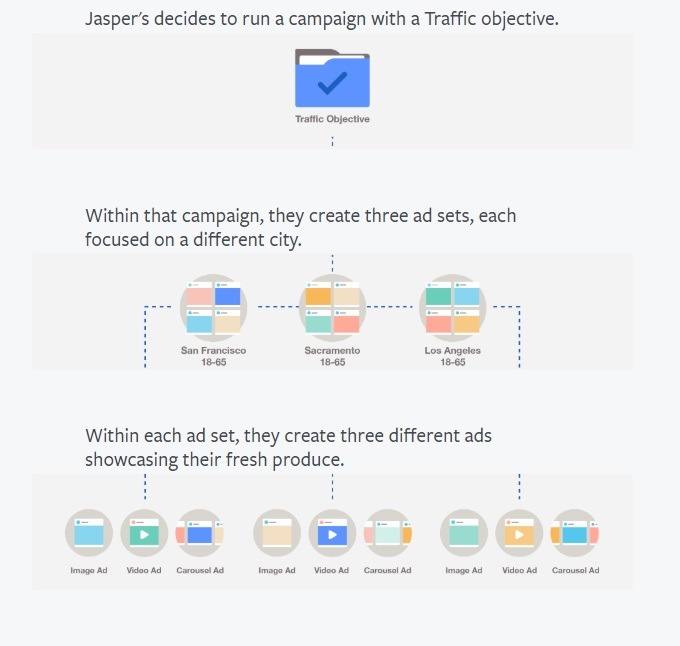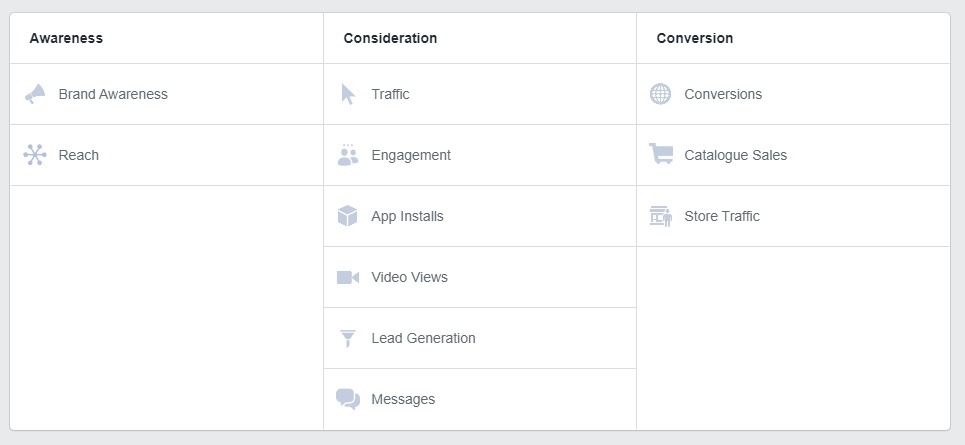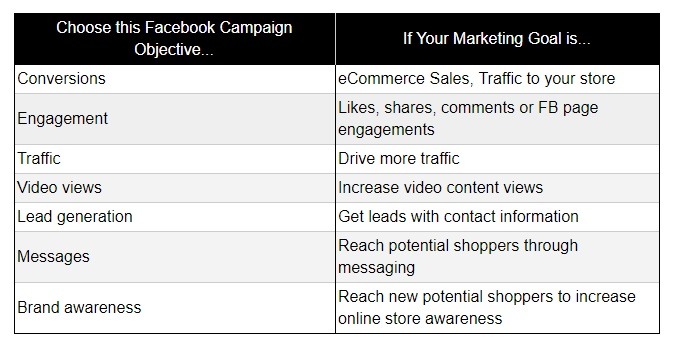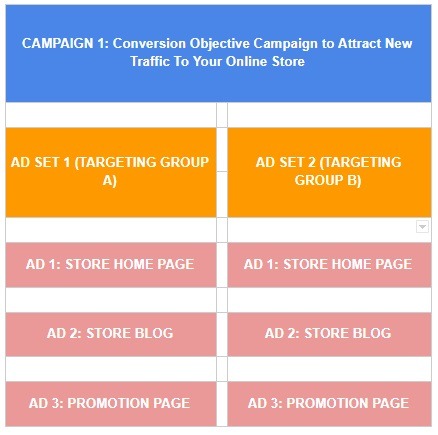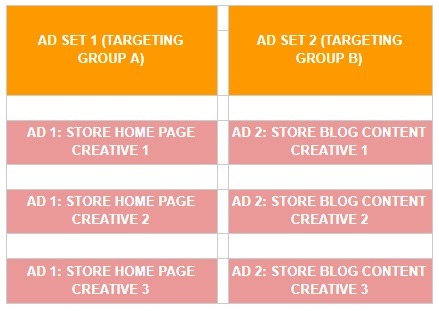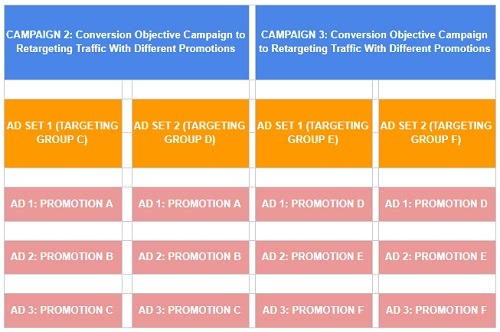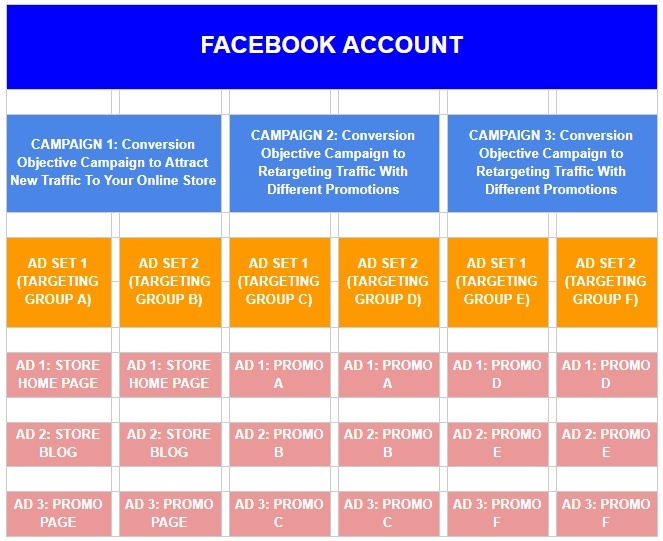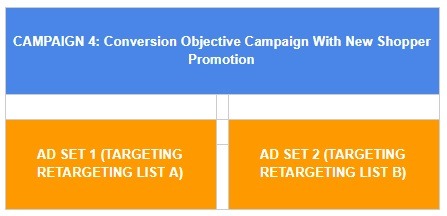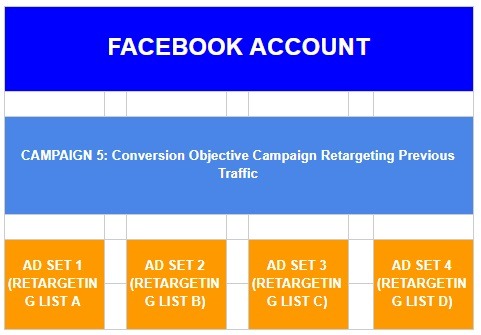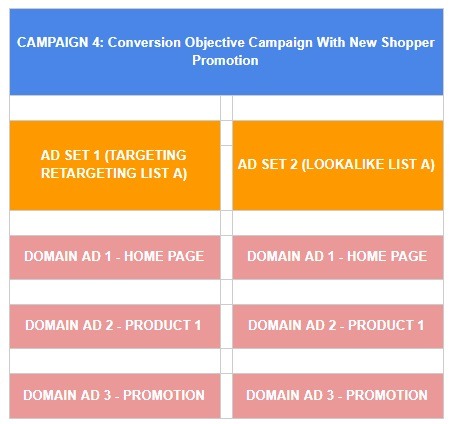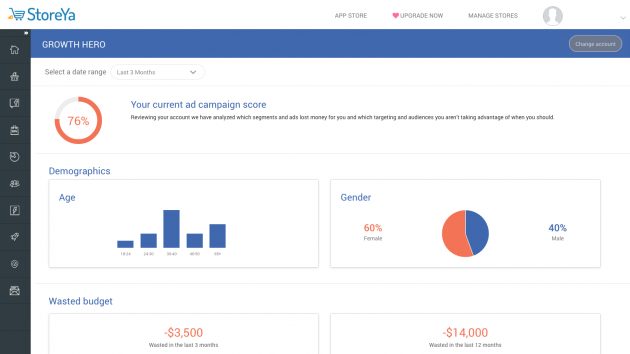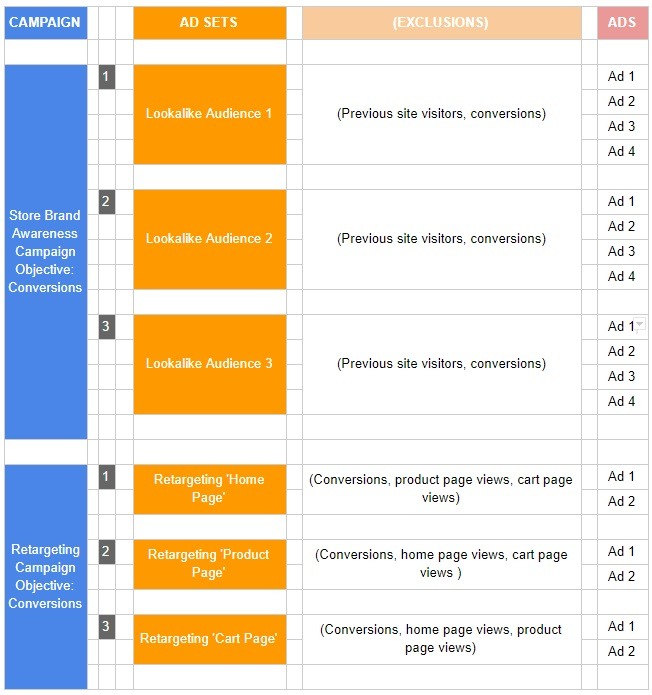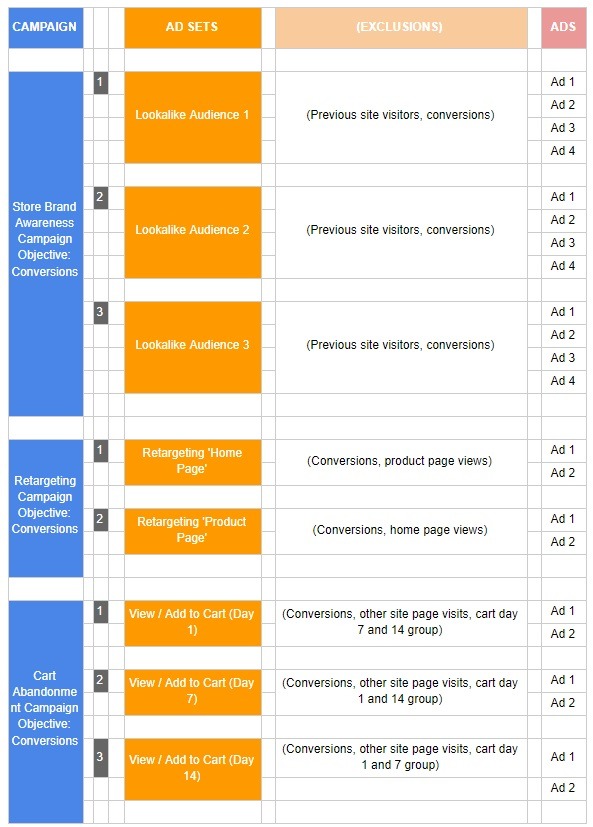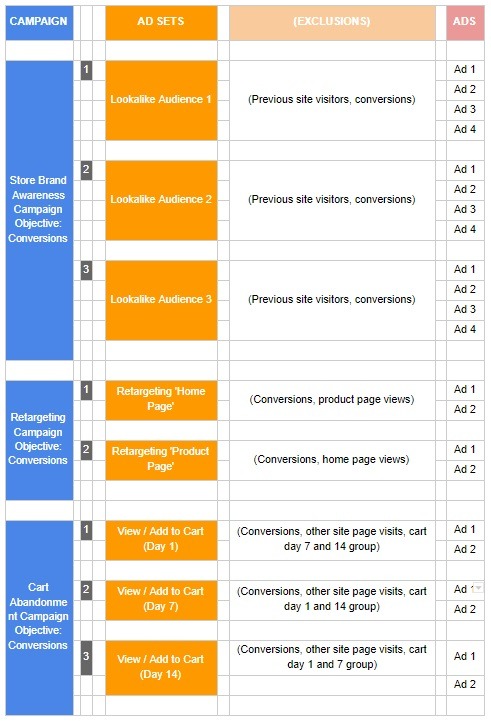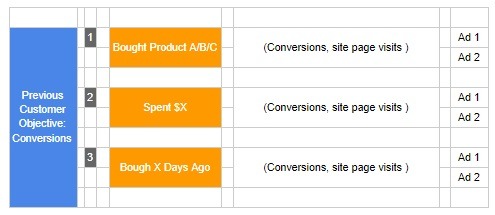Here’s the bottom line: the path to high-converting Facebook ads starts with ensuring you have the best Facebook account and campaign structure for success. Why? Because the right Facebook ad campaign structure will enable you to build your strategies and optimize your campaigns at every level to ensure you are getting the best ROAS. Think of it as your Facebook marketing foundation, a foundation that will help you scale your marketing for the best results.
A successful Facebook campaign structure should have a multitude of campaigns fulfilling different objectives, each of which having a variety of ad sets, each with its own targeting and bid strategies. On top of that, each ad set should offer a variety of ad formats.
For those of you who are newer, or struggling with Facebook marketing, here’s a beginner’s breakdown of what we mean here:
Facebook Campaign Structure Levels
A Facebook structure has three levels: the campaign, the ad sets and the ads. At the campaign level, you set your overall objective for your campaign. Your ad sets are where you split your campaign into groups based on budget, targeting, placements and bids. The last level is your ads, where you create your creative format options for each ad set.
And why should you have more than one campaign? Because each campaign should be using a different objective to address the various eCommerce sales funnel goals you have. This ensures that Facebook is working hard to help you achieve that one specific goal for your campaign, improving your chances of success. It will also help you better optimize your campaigns for the best ROAS in the long run. And as an added bonus, one campaign per goal will keep your Facebook organized, helping you with marketing admin as your business and advertising budget grows.
Here’s an example of a complete campaign structure from Facebook:
Now that we’re all on the same page, let’s dig deep into how you can create the best Facebook ad campaign structure. Here we will give you all the steps you need to create a good performing campaign at each of these levels and then provide some Facebook ad Campaign structure strategies that we recommend for eCommerce.
Let’s jump in!
Step 1: Building an Optimized Facebook Account Structure at Campaign Level
The very first step in ensuring you have the right Facebook ad campaign structure is setting a clear marketing goal for your campaign. This happens at the campaign level and will provide the whole foundation of your campaign and its ad sets and ads. It will also set your intention in terms of optimizing the campaign for the best Facebook ROAS.
Facebook offers awareness, consideration and conversion campaign types, with each option tailored to one specific goal.
Which eCommerce Facebook Campaign Objective Should I Use?
It’s important to note here, when it comes to eCommerce Facebook marketing you are almost always going to choose the ‘conversions’ objective. Even if your overall goal for your campaign is to attract new shoppers, remarket previous traffic or reach out to existing customers.
This is because by picking this objective you are working with Facebook’s algorithms, which are designed for each specific objective (to reach potential shoppers who are more likely to buy), and thus improve campaign success chances.
In short: unless you’re a mega eCommerce brand with a very specific strategy that requires a different objective, choose ‘conversion’ campaigns for all your marketing goals!
Beginner Side Note: Here is a quick cheat sheet of all Facebook campaign objectives and their matching marketing goals according to Facebook.
Let’s say you currently have two main marketing objectives: you want to drive more new, targeted traffic to your online store and increase sales through marketing, AKA conversions.
You could then create two conversion-objective campaigns, one with the goal to attract new shoppers and drive them to your store, and one to boost conversions by targeting people already familiar with your brand.
Here’s a rough idea of what these two campaigns could look like:
Facebook Campaign Structure Example 1
As we mentioned, this campaign aims to bring new potential shoppers to your online store using Facebook’s conversion campaign objective.
The idea with this simple structure is that you are able to have multiple ad sets that send shoppers to various pages of your store. This ensures that, with the help of Facebook’s optimization algorithms, you will quickly be able to see which ads are winning and which are bombing and more easily adjust accordingly.
Very Important Pro Tip: Additionally, you should be A/B testing all your ads and creatives to find the best performing ad. Therefore, your structure could look something like this until you narrow it down the three ads.
There are a lot of ways it can be applied beyond what we have shown you above. One effective way of using it would be to create a traffic campaign around your eCommerce blog content, where each ad would highlight and link to a different blog post.
What about the second campaign example to push product sales?
Facebook Campaign Structure Example 2
Here’s a simple example of how you can boost product sales using Facebook’s campaign conversion objective. Similar in structure to the above, here you have one conversion campaign where you’re pushing one promotional product. You can then target two different groups with three types of ads. This enables you to show your different audiences three variants of ads, while making it easier for you to keep high converters and optimize or pause non-converters.
Okay, but what if you want to run more than one promotion to push those sales to a variety of market segments? Well, then it will look more like this:
Newbie Tip: A lot of new Facebook advertisers tend to create different promotional ads at the ad level, which in turn creates chaos for managing and optimizing campaigns for the best ROAS. What you absolutely should be doing is creating each promotional campaign at campaign level. In other words, you should be creating a conversion campaign for each promotion, product and/or group of products.
With the above structure, you will be able to run long-term campaigns, while cycling your ad sets and changing your ad creatives to help you boost sales and fight fatigue. By keeping each promotion under its own campaign, you will be able to manage your ad spend, better track and optimize campaign results and more efficiently make the tweaks you need to push your conversions up while keeping your costs low.
Let’s put both examples together to show you how an account would look if it were running one traffic campaign and two promotion conversion campaigns.
The idea is to create specific campaigns for each promotion under one umbrella, so to speak, as this will allow you to easily adjust your budgets, targeting and ad creatives within in. You can then increase the number of campaigns in your Facebook account as your marketing needs, budgets and business grows.
Step 2: Building an Optimized Facebook Account Structure at Ad Set Level
Now that we have an understanding of how you set your objectives – and campaign goals – at campaign level, we will need to dig deeper into your campaign targeting and budget. Therefore, the next step in building your optimum Facebook account structure is building your ad sets.
We highly recommend creating an ad set per audience. Properly creating and segmenting your ad sets by your audience targeting will allow you to optimize bids and budgets based on their performance.
Newbie Tip: If you’re new to Facebook targeting or want to up your game for better Facebook ad success, then these three guides will be a huge help.
- 5 Ways to Hack Facebook’s Custom Audiences for Big Payoffs
- 4 Quick Strategies to Make Your Facebook Custom Audiences More Effective
- 6 Easy Steps to Better Targeting With Facebook Audience Insights
Let’s dig deeper into the campaign example we used in step one and assume you want to run a specific promotional campaign that targets a variety of potential customers at different stages of their brand awareness journey: new potential shoppers and users who are already familiar with your brand or existing customers.
You could then create one campaign with a variety of ad sets which target different audiences. In this example, we have gone simply with two groups of previous visitors and/or shoppers (retargeting lists).
It is crucial at this stage that you have managed to create Facebook target audiences that have limited overlap. Audience overlap happens quite easily if you’re not keeping an eye on audiences during ad set creation. Having a good, organized Facebook ad campaign structure goes a long way to preventing this, especially at the ad set creation stage.
Note: Don’t forget to use Facebook’s Audience Overlap tool to spot and fix any audience overlaps quickly.
Having refined, highly segmented audiences is key, as it will enable you to clearly see which audiences are performing successfully. In other words, it allows you to optimize, pause or boost ad sets more easily. The above table shows a simplistic example of this. Eventually, you will want to break these down further as your campaigns, targeting lists and advertising needs grow.
Newbie Tip: Facebook offers core, custom and lookalike audience targeting. Here’s a short outline of each:
- Core audiences, in which Facebook advertisers create an audience based on demographic criteria such as age, interests, location, etc.
- Custom audiences, in which Facebook advertisers, after setting up a Facebook pixel, can automatically create audiences based on users’ actions on your store.
- Lookalike audiences, in which Facebook advertisers create an audience based on interests, helping them find new shoppers similar to their current customers.
Step 3: Building an Optimized Facebook Account Structure at Ad Level
Step three in creating a good Facebook ad campaign structure is ensuring that you build out your Facebook ad structure. The fact that this is the final level of your Facebook campaign structure hierarchy, doesn’t mean it is any less critical. There are a variety of ad types you can choose, depending on the campaign objective and placement settings you have selected. The top Facebook ads for eCommerce include:
- Dynamic Ads
- Collection Ads
- Video Ads
- Domain Ads
- Messenger Ads
- Instant Experience Ads
- Lead Ads
- Carousel Ads
- Offer Ads
There are a variety of ways you can build your ads for each ad set, and these are where things can get tricky if you’re not organized. What you should be doing is creating a few ads with different messaging, which you would then duplicate for each of the ad sets you’ve created in your Facebook campaign. This means you will be able to track how each ad does with each audience and optimize accordingly.
Again, let’s look at our basic Facebook traffic campaign example, in which you are targeting a retargeting list and a lookalike campaign, and assume you are running three domain ads for each. One domain ad linking to your store homepage (branding), one to a specific popular product, and one to your promotion landing page.
You would create each of the ads for your first ad set and then duplicate them for other ad sets in your campaign. After which, you will probably need to tweak your messaging (headline and CTA text) for that specific audience.
Bonus Content: 9 Facebook CTA Tips & Hacks to Drive eCommerce Conversions
As your business needs and budget increase, so will the number of ads in each of your campaigns. What you will want to do is keep a close eye on your ads – rotating ads to avoid fatigue and keeping a close eye on the ads that are working and those that are killing your ROAS – and make your optimization changes accordingly.
Pro Tip: Use the free Growth Hero app to get a full Facebook Ads account audit today. The app helps you find out which campaigns and ad sets are losing money, which devices and operating systems are converting best for your store, your best-performing audiences and cross-segment options to improve results – all in a matter of minutes.
Step 4: Building Expert Facebook Campaign Structures from Your Facebook Account
Now that you have a clearer idea of how to structure your Facebook Ads account and campaigns for easier management and optimization and better results, let’s go through some expert Facebook ad campaign structure examples. We will outline three possible Facebook ad campaign structures, based on different sales funnel stages, which you can use as inspiration for your own winning Facebook campaign structure for your Facebook account.
It is important to note here that there is no one-size-fits-all strategy.
You should be creating your Facebook ad account and campaign structure based on your sales funnel and goals, and at the campaign level, your metrics.
What we do highly recommend is keeping your campaigns as super focused as possible – by creating a campaign for each specific eCommerce business goal and targeted ad sets for each drilled-down market segment. Both of these strategies will help you improve your ROAS, make it easier for you to optimize, and therefore, ultimately increase conversion success.
Here are some eCommerce Facebook ad campaign structures to get your creative marketing juices going:
Example 1: Basic eCommerce Facebook Account and Campaign Structure
Below is a top-funnel campaign structure for a smaller online store with one product. Here you would be using two different campaigns to first drive awareness for your brand, and second, retarget that traffic with a promotional landing page for conversions.
Remember, by setting your campaign Facebook objective as ‘Conversions,’ you are letting Facebook know to look for potential shoppers to show your ads to those who are more likely to convert.
In this eCommerce campaign structure, you are using lookalike audiences of previous shoppers to drive awareness for your online store brand and product. Traffic is then targeted, based on which pages they viewed on your store, with retargeting Facebook ads.
Example 2: Intermediate eCommerce Facebook Account and Campaign Structure
For this eCommerce Facebook account and campaign structure example, let’s assume you are still a smaller online store, but are selling more than one product. You might also be a little more established and have a bigger marketing budget. In this case, you could further segment your campaigns, which in this example would be splitting your remarketing campaigns.
Similar to the first campaign structure example, with this template you use campaigns to target different lookalike audiences to build awareness for your online store and products. You would then split your retargeting campaigns into two, allowing you to target more finite activity on your pages specifically for cart abandonment remarketing. Which, in this case, you are ensuring you are excluding people who have bought from previous ads or who have seen other cart ads.
Example 3: Full Expert eCommerce Facebook Account and Campaign Structure
Finally, let’s look at a Facebook account and campaign structure that could be implemented by more established eCommerce brands with big product categories. Here, you would increase the number of your campaigns, so that you are creating a full-funnel marketing strategy.
What is important, again, is including the right exclusions and targeting so that potential shoppers and customers are moved up and down the funnel, until they buy and then returned back into the fold.
Pro Tip: As your accounts and campaign structures get more involved, it is very beneficial for marketers to make use of Facebook’s Automation Rules so that you can scale your ads automatically. This will enable you to set important notifications, adjust bids and budgets, and turn ads on and off automatically. Here are 3 Ways to Optimize Your Facebook Ads on Autopilot to get you started.
—
In a nutshell, the more segmented and well organized your Facebook ad campaign structure is, the easier it will be to optimize, watch spending and boost your Facebook ROAS. You want to start small and build out as we have shown – and most importantly – highly segment your campaigns at campaign, ad set and ad level. For more expert Facebook marketing tips, visit our top Facebook Ad guides.
- Ultimate Guide to Improving Facebook Ad Performance
- 12+ Facebook Stats Online Sellers Need to Know
- How to Quickly Optimize Facebook Ads for More Online Sales
- Why and How to Integrate Facebook and Paid Search Marketing Strategies
- How to Leverage Facebook and Instagram to Scale a 7-Figure Business

Nicole is a content writer with over sixteen years experience and flair for storytelling. She runs on a healthy dose of caffeine and enthusiasm. When she's not researching the next content trend or creating business content strategies, she's an avid beachgoer, coffee shop junkie and hangs out on LinkedIn.
Recommended articles
 Facebook Ads for eCommerce: 16 Strategies, Examples & Tips
Facebook Ads for eCommerce: 16 Strategies, Examples & Tips
 How to Build a Winning eCommerce Ads Strategy
How to Build a Winning eCommerce Ads Strategy
 Google Ads for eCommerce: Everything You Need to Know
Google Ads for eCommerce: Everything You Need to Know
 10X Your Traffic with PPC Management Software
10X Your Traffic with PPC Management Software
Comments
Powered by Facebook Comments

